
Plant June month
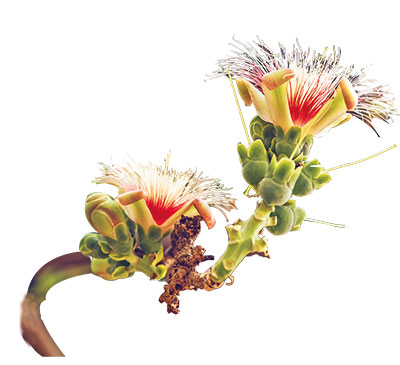 Wild Guava
Wild Guava
Wild guava or Careya Arborea Roxb. is a tree species native to India. It is dry, deciduous in nature, reaching a height of 20 metres. Its leaves are very large, spathulate and beautifully red before they fall. Wild guava is visually interesting. Its flowers are large and numerous and cover all its branches and branchlets. The gleaming white of the flowers is created with millions of stamens. The base of the stamens changes into deep red after pollination. These red-based white stamens are a joy to look at during the dry summer months. Wild guava is a gorgeous tree that can decorate gardens, avenues or townships. Its Sanskrit name, Kumbhi, refers to the shape of the fruit which looks like a water-pot. The tip of the fruit is crowned with persistent sepals. Ayurveda uses this species to treat various types of coughs and colds. Wild guava fruits are very aromatic and edible. This tree grows throughout India, from dry forests to the semi-evergreen forests of the Western Ghats.
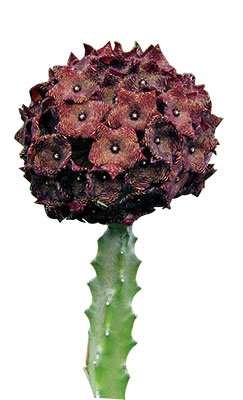 Umbelled Caralluma
Umbelled Caralluma
Umbelled Caralluma or Caralluma umbellata Haw is a succulent plant (not a cactus), which reaches 60 cm in height. It is endemic to South India. The plant’s stems are four-angled, almost leaf-less. This species has the unique ability to store so much water that it can grow in and withstand desert conditions. In summer, the tips of its stems transform into glorious, globose flower-heads, densely packed with many bell-shaped flowers. These flowers are reddish-brown with numerous transversions of yellow and purple streaks throughout the corolla, providing a wealth of intriguing colour to gardens or containers. The fruits too are unique, always paired and cylindrical, tapering towards apices and looking like miniature horns of animals. The green stems may turn pinkish-red in the summer heat. Umbelled Caralluma can spruce up the house and be used as a wonderful houseplant. This species can be used to decorate even a tiny space. Medicinally, the plant is known for its antibacterial and antioxidant properties.
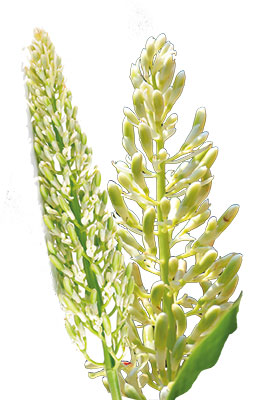 Blue Ginger
Blue Ginger
Blue Ginger, also called Greater Galangal or Alipnia Galanga (L.) Willd., is a perennial shrub native to southeast Asia. Its rhizomes and stalks are aromatic. Shoots of this shrub are very long, shining and bear erect inflorescence of 10 to 15 cm dense spikes. Blue Ginger’s flowers are large, leathery, greenish-white to yellow, occasionally streaked with pink. Its breathtaking blooms are long-lasting and look wonderful against its large and shiny foliage. Hence, it is considered a good choice for yards and gardens. This shrub can also be used to highlight a semi-shaded landscape. It is useful as a tall informal hedge or as a screen or backdrop.
Blue Ginger is used to combat cough, asthma and fever.
 Asian Bush-beech
Asian Bush-beech
Gmelina asiatica L., popularly known as Asian Bush-beech, is a much-branched, spiny shrub reaching 10 metres in height. It is native to India and East Asia and grows naturally in India’s tropical thorn forests and other warmer regions. Its leaves are strikingly small, dark green above and glossy green beneath and look beautiful against sunlight. The shrub’s flowers are showy, bright yellow in colour, nodding in terminal clusters. The flowers attract pollinators and birds. Its numerous branches and flowering twigs make it a focal point in a garden. It can be planted as a single specimen. Asian Bush-beech is a compact shrub with dense foliage. Hence it can be maintained as a clipped hedge. Even its pear-shaped fruits, which turn yellow from green on ripening, add gleam to landscapes. Its roots and leaves are traditionally used as blood purifiers.
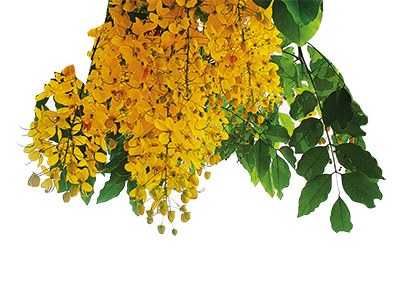 Indian Laburnum
Indian Laburnum
The Indian Laburnum, or Cassia fistula L., is a semi-deciduous to evergreen tree with spreading branches, reaching 15 to 20 metres. It is native to India and Sri Lanka. Indian Laburnum is known for profuse flowering, therefore it is also called golden shower. The flowers are showy and bright-golden yellow. The fruits are dry pods, elongated and rod-shaped, hanging from pendulous stalks. This tree is very attractive and adjusts to many climatic conditions ranging from semi-desert to high rainfall. Adding this tree to your home is worth the effort as it is considered highly auspicious. Golden shower trees are loved for their dazzling display of golden blossoms that burst forth ahead of their leaves in mid-summer. Planted near a patio, the tree creates a beautiful summertime ambience for visitors. Its flowers attract various butterflies too! The root, bark, leaf, flower, fruit and seed of the tree are said to have medicinal properties which treat fever, constipation, jaundice, ringworm, dysentery, urinary disorders and cardiac complaints.
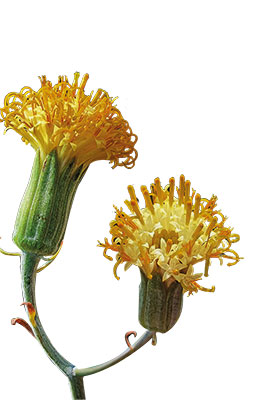 Kleinia
Kleinia
Large-flower kleinia, scientifically known as Kleinia grandiflora (Wall. ex DC.) N. Rani, is a (sub-)succulent subshrub growing upto two metres tall. Its stems are usually leaf-less below with the leaf-scars lending it a ‘cactus look’. It is one of the wild ornamental species least used in gardening. The leaves are fleshy and known as Muyalkaathu in Thamizh and Kundeluchevi in Telugu which means ‘ear of rabbit’, alluding to its shape. The flower-heads are three cm across, arising from the top of the branches. The florets are white, and turn golden-yellow on maturity. This bloom makes the garden look cool with its white flowers during the scorching summer and is ideal for desert landscaping and drought-tolerant gardens. It can be used as the focal point of a drought-tolerant succulent garden due to its height. In the wild, it tends to be seen hanging down from rocky slopes, hence planting on slopes will give it a natural look. It is also a good choice for xeriscape and rock gardens. Single specimens are eye-catching in containers. Medicinally, the leaves are used for earache. It grows almost throughout the drier regions of India.
Comments
Currently there are no Comments. Be first to write a comment!



